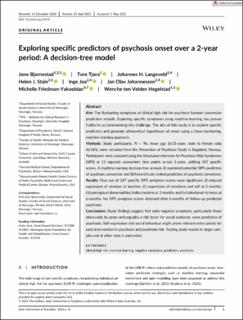| dc.contributor.author | Bjørnestad, Jone Ravndal | |
| dc.contributor.author | Tjora, Tore | |
| dc.contributor.author | Langeveld, Johannes Hendrik | |
| dc.contributor.author | Stain, Helen J. | |
| dc.contributor.author | Joa, Inge | |
| dc.contributor.author | Johannessen, Jan Olav | |
| dc.contributor.author | Friedman‐Yakoobian, Michelle | |
| dc.contributor.author | Hegelstad, Wenche ten Velden | |
| dc.date.accessioned | 2021-08-11T13:10:18Z | |
| dc.date.available | 2021-08-11T13:10:18Z | |
| dc.date.created | 2021-05-18T12:45:11Z | |
| dc.date.issued | 2021-05 | |
| dc.identifier.citation | Bjørnestad, J., Tjora, T., Langeveld, J.H. et al. (2021) Exploring specific predictors of psychosis onset over a 2-year period: A decision-tree model. Early Intervention in Psychiatry. | en_US |
| dc.identifier.issn | 1751-7885 | |
| dc.identifier.uri | https://hdl.handle.net/11250/2767407 | |
| dc.description.abstract | Aim
The fluctuating symptoms of clinical high risk for psychosis hamper conversion prediction models. Exploring specific symptoms using machine-learning has proven fruitful in accommodating this challenge. The aim of this study is to explore specific predictors and generate atheoretical hypotheses of onset using a close-monitoring, machine-learning approach.
Methods
Study participants, N = 96, mean age 16.55 years, male to female ratio 46:54%, were recruited from the Prevention of Psychosis Study in Rogaland, Norway. Participants were assessed using the Structured Interview for Psychosis Risk Syndromes (SIPS) at 13 separate assessment time points across 2 years, yielding 247 specific scores. A machine-learning decision-tree analysis (i) examined potential SIPS predictors of psychosis conversion and (ii) hierarchically ranked predictors of psychosis conversion.
Results
Four out of 247 specific SIPS symptom scores were significant: (i) reduced expression of emotion at baseline, (ii) experience of emotions and self at 5 months, (iii) perceptual abnormalities/hallucinations at 3 months and (iv) ideational richness at 6 months. No SIPS symptom scores obtained after 6 months of follow-up predicted psychosis.
Conclusions
Study findings suggest that early negative symptoms, particularly those observable by peers and arguably a risk factor for social exclusion, were predictive of psychosis. Self-expression and social behaviour might prove relevant entry points for early intervention in psychosis and psychosis risk. Testing study results in larger samples and at other sites is warranted. | en_US |
| dc.language.iso | eng | en_US |
| dc.publisher | John Wiley & Sons Ltd. | en_US |
| dc.rights | Navngivelse 4.0 Internasjonal | * |
| dc.rights.uri | http://creativecommons.org/licenses/by/4.0/deed.no | * |
| dc.subject | psykiatri | en_US |
| dc.subject | psykose | en_US |
| dc.subject | psychosis | en_US |
| dc.title | Exploring specific predictors of psychosis onset over a 2‐year period: A decision‐tree model | en_US |
| dc.type | Peer reviewed | en_US |
| dc.type | Journal article | en_US |
| dc.description.version | publishedVersion | en_US |
| dc.rights.holder | © 2021 The Authors | en_US |
| dc.subject.nsi | VDP::Medisinske Fag: 700::Klinisk medisinske fag: 750::Psykiatri, barnepsykiatri: 757 | en_US |
| dc.source.pagenumber | 8 | en_US |
| dc.source.journal | Early Intervention in Psychiatry | en_US |
| dc.identifier.doi | 10.1111/eip.13175 | |
| dc.identifier.cristin | 1910491 | |
| dc.relation.project | Helse Vest RHF: 911881 | en_US |
| dc.relation.project | Stiftelsen Dam: 913184 | en_US |
| dc.relation.project | Helse Vest RHF: 911508 | en_US |
| cristin.ispublished | true | |
| cristin.fulltext | original | |
| cristin.qualitycode | 1 | |

